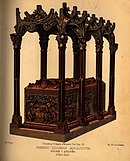Casimir IV Jagiellon
You can help expand this article with text translated from the corresponding article in Polish. (October 2020) Click [show] for important translation instructions.
|
| Casimir IV | |||||
|---|---|---|---|---|---|
John I Albert | |||||
| Born | 30 November 1427 Kraków, Poland | ||||
| Died | 7 June 1492 (aged 64) Old Grodno Castle | ||||
| Burial | , Kraków | ||||
| Spouse | |||||
| Issue Detail |
| ||||
| |||||
Jagiellon | |||||
| Father | Władysław II Jagiełło | ||||
| Mother | Sophia of Halshany | ||||
Casimir IV (Casimir Andrew Jagiellon;
The
(KG), the highest order of chivalry and the most prestigious honour in England.Following Casimir's death in 1492, John I Albert succeeded him as King of Poland, and Alexander Jagiellon was proclaimed Grand Duke of Lithuania.[4]
Youth
Casimir Jagiellon was the third and youngest son of King Władysław II Jagiełło and his fourth wife, Sophia of Halshany.[5] He often relied on his instinct and feelings and had little political knowledge, but shared a great interest in the diplomacy and economic affairs of the country. Throughout Casimir's youth, Bishop Zbigniew Oleśnicki was his mentor and tutor, however, the cleric felt a strong reluctance towards him, believing that he would be an unsuccessful monarch following Władysław's death.
Grand Duke of Lithuania
The sudden death of
During Casimir's rule the rights of the Lithuanian nobility — dukes, magnates, and
King of Poland
In 1427, the
Casimir succeeded his brother
That same year, Casimir was approached by the
Elisabeth's only brother Ladislaus, king of Bohemia and Hungary, died in 1457, and after that Casimir and Elisabeth's dynastic interests were directed also towards her brother's kingdoms.
King Casimir IV died on 7 June 1492 in the Old Grodno Castle in the Grand Duchy of Lithuania, which was in a personal union with Poland.
Foreign policies

The intervention of the
In 1490, Casimir's son
Around 1480 Casimir was allied with the
Tomb

Casimir was interred at Wawel Cathedral in Kraków, in a red marble tomb sculpted by Veit Stoss.[12] In 1973 a research team of 12 experts opened the tomb. Shortly afterward, 10 of the team died prematurely. It was subsequently found that the deaths were caused by toxins originating from fungus present in the tomb.[13]
Children
- as Vladislaus II.
- Landshut Wedding" took place in Bavariawith much pomp and celebration in 1475, starting a tradition which continues to this day.
- Casimir Jagiellon (3 October 1458 – 4 March 1484); was to have married Kunigunde of Austria, but instead chose religious life, eventually being canonized as Saint Casimir.
- John I of Poland(27 December 1459 – 17 June 1501); succeeded Casimir IV as the king of Poland (1492–1501)
- Alexander I of Poland(5 August 1461 – 19 August 1506); King of Poland (1501–1506)
- Frederick V of Brandenburg-Ansbach[14]
- Sigismund I the Old (1 January 1467 – 1 April 1548); King of Poland (1506–1548)
- Frederick Jagiellon (27 April 1468 – 14 March 1503); Bishop of Kraków (1488–1503), Archbishop of Gniezno and Primate of Poland (1493–1503).
- Anna Jagiellon (12 March 1476 – 12 August 1503); married Bogislaw X, Duke of Pomerania; they had eight children, including Sophie of Pomerania, who became queen of Denmark
- Barbara (15 July 1478 – 15 February 1534); married Duke Georg dem Bärtigen of the Saxony
- Elizabeth Jagiellon (13 November 1482 – 16 February 1517); married Frederick II of Legnica
- Two additional daughters named Elizabeth[15]
Gallery
-
Casimir IV in advanced age, by Jan Matejko
-
Portrait of King Casimir, by Aleksander Lesser, 1860
-
Giovanni da Capistranoand King Casimir IV
-
Statue of Casimir IV Jagiellon in Malbork
-
Poland and Lithuania in 1466, under Casimir's rule
-
Polish knights and soldiers during the times of Casimir
-
Polish stamp, 1938
See also
- History of Poland during the Jagiellonian dynasty
- History of Lithuania
- List of Poles
- Statutes of Nieszawa
Citations
- ^ Frost 2015, p. 327.
- ^ "Casimir iv – Encyclopedia Article and More from Merriam-Webster". Archived from the original on 24 October 2014.
- ^ "Poland – history – geography". Retrieved 13 February 2017.
- ^ "Valentas Šiaudinis. Lietuvos didžiųjų kunigaikščių kova už LDK savarankiškumą 15 a." Voruta (in Lithuanian). 10 January 2020. Retrieved 26 December 2023.
- ISBN 978-83-01-07291-9.
- ^ a b c J. Kiaupienė Valdžios krizės pabaiga ir Kazimieras Jogailaitis. Gimtoji istorija 2: Nuo 7 iki 12 klasės (Lietuvos istorijos vadovėlis). CD. (2003). Elektroninės leidybos namai: Vilnius.
- ^ Lietuvių kalba ir literatūros istorija Archived 26 October 2007 at the Wayback Machine
- ^ Stryjkowski, Maciej (1582). Kronika Polska, Litewska, Zmódzka i wszystkiéj Rusi. Warszawa Nak. G.L. Glüsksverga. p. 207. Retrieved 17 July 2021.
- ^ "Kurie Lietuvos valdovai mokėjo protėvių kalbą, kurie – ne? / Laida "Lietuva – mūsų lūpose"". YouTube.com (in Lithuanian). Palace of the Grand Dukes of Lithuania. Archived from the original on 11 December 2021. Retrieved 3 October 2021.
- ^ "Jagiellonians Timeline". Jagiellonians.com. University of Oxford. Retrieved 20 April 2021.
- ^ Bain 1911, p. 448.
- ISBN 978-0-415-97385-4.
- ISBN 978-1-76046-218-5.
- ^ Ward, Prothero & Leathes 1934, p. table 37.
- ^ Paweł Jasienica, Jagiellonian Poland
General and cited sources
- This article incorporates text from a publication now in the public domain: Bain, Robert Nisbet (1911). "Casimir IV.". In Chisholm, Hugh (ed.). Encyclopædia Britannica. Vol. 5 (11th ed.). Cambridge University Press. pp. 447–448.
- Frost, Robert (2015). The Making of the Polish-Lithuanian Union 1385–1569, Volume 1. Oxford: Oxford University Press. ISBN 978-0-19-101787-2.
- Ward, A.W.; Prothero, G.W.; Leathes, Stanley, eds. (1934). The Cambridge Modern History. Vol. XIII. Cambridge at the University Press.







